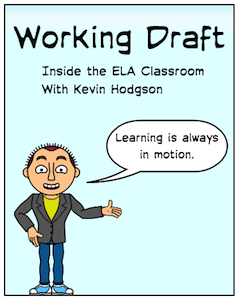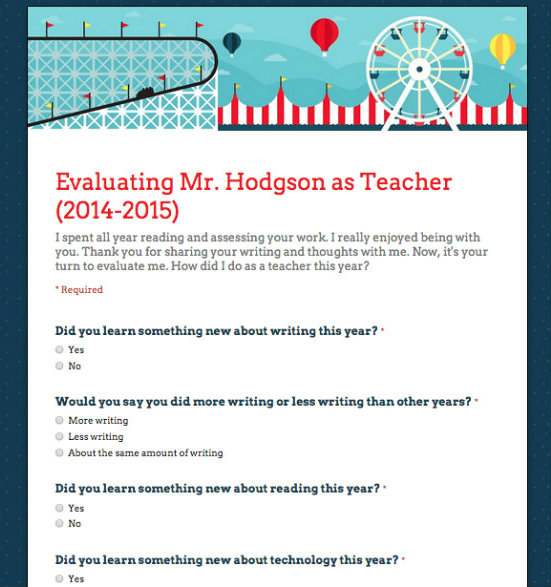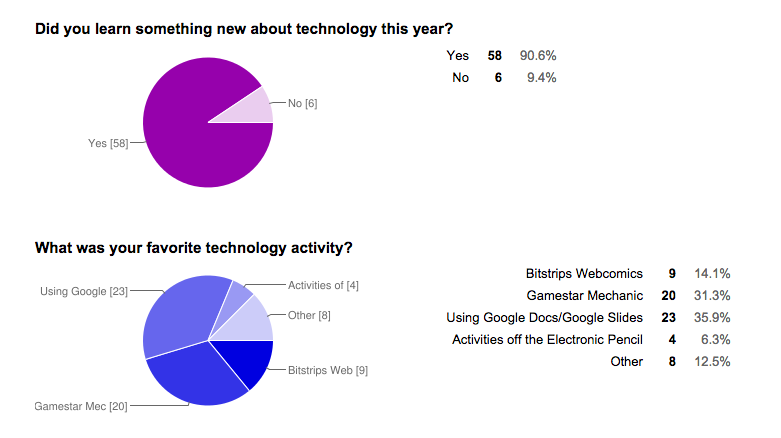How Sixth Graders Evaluated Their Teacher
A MiddleWeb Blog
 The writing is on the wall. Sometime, in the next year or two, our newly-instituted teacher evaluation process will begin to include student feedback, along with SMART goals and archived materials to document teaching practice. While some of my colleagues have expressed reservations about this shift to including students, I am mostly just curious about it.
The writing is on the wall. Sometime, in the next year or two, our newly-instituted teacher evaluation process will begin to include student feedback, along with SMART goals and archived materials to document teaching practice. While some of my colleagues have expressed reservations about this shift to including students, I am mostly just curious about it.
What would my sixth grade students say about the year they spend with me in our English Language Arts classroom?
I decided to ask them.
The other day, with just a few weeks left in the school year, I explained to my students that I had been honored to spend so many months with them – teaching all sorts of units, reading their writing, offering feedback, introducing technology – and now it was time for them to grade me.
There were some interesting verbal responses to that offer, including wisecracks about how I was doomed to failure. One student joked, “Is there such a thing as an F-minus?” and another asked, “Can we grade the other teachers, too?”
A straightforward Google Form
I decided to use a Google Form to gather feedback from my students. My form was loosely modeled on some work that blogger Larry Ferlazzo has done with his English Language Learner classes. I had intended to revamp some of Larry’s questions (he teaches high school), but then found that I had more than enough of my own points of inquiry around literacy.
While this was more of an informal experiment than a formal research endeavor, I was genuinely curious about students’ perceptions of my teaching style and their classroom experiences.
Here are some of my takeaways from the results of the survey of my sixth grade students. All responses were anonymous. The 15-question survey took students about 15 minutes to complete. I was in the room, to help, but I kept my presence away from students as much as possible to avoid influencing them.
90% learned something
First of all, nearly 90 percent of my students say they learned something new about writing this year. That’s a number I am quite happy about, considering I am building on the writing instruction of my colleagues from the past. But more importantly, a solid 81 percent of my students perceive themselves as “better writers” at the end of the year than they were when we began in September.
One of my goals as a teacher is to help all of my students see themselves as “writers” — and I teach a co-taught class with many students on learning plans whose self-perceptions of themselves as writers is a huge hurdle — so this number really heartens me.
Technology for learning
We do quite a bit with technology and literacy, as readers of this column know, and there are not many teachers in my school who are pushing the edges of digital assisted learning. Much of what we do is new for students. In fact, the one colleague who has been my companion with technology integration — Gail Poulin, kindergarten teacher — is retiring this year, which makes me a bit sad, as Gail and I often talked about the role of technology and learning from the early grades in our school to the later grades in our school. I’ll miss those conversations and professional collaborations.
I do try to push the edge in our sixth grade classroom, right from the first days of school, so I was not surprised by the 90 percent figure of students learning something new with technology. And the fact that they indicated the use of Google Docs and Video Game Design as two favorite activities is also unsurprising. I saw that in the classroom on a regular basis.
My preparedness grade
Moving into the more nitty-gritty elements of teaching and learning, I asked students to rate my effectiveness and preparedness as an educator. I was happy to see high numbers in most of the categories, but still think I have work to do to be a better teacher with more engaging activities around writing and literacy.
On the way to meeting expectations
I also gave students an opportunity to give me an overall grade, using the same “standards-based” assessment system that I have to use with them. I would like to see that response in the M (Meeting student expectations of an ELA teacher) grow a bit more, of course, and I wonder about the ones who indicated that I was not meeting expectations (N). Maybe I should have included a text box option, for comments or defense of the grade. Those responses could be outliers (ie, students not taking the survey seriously) or they could be a real perception of a terrible year with me. I hope not.
In their own words
I did leave room for general comments, under the prompt of “What else should Mr. Hodgson know about your year? What can he do to become a better teacher?”
Here are some of the responses from students:
- More creative writing!
- I would like you to know that this year was really fun. You helped me become a better writer and have helped me in areas where I needed help.
- Less open response. More technology.
- Sometimes, you were strict. But you were a good teacher.
- You engaged me with your teaching and let me be myself.
- I had an amazing year in ELA. I have grown so much as a writer and reader.
- I found my voice as a writer this year. I discovered that I love writing comedy pieces.
- Don’t teach Parts of Speech.
- (You) taught me skills and techniques that will stay with me through my academic life.
- I had a fun time in class this year. I had a chance to be creative with writing and reading and technology.
This activity of collecting data and impressions from students has been interesting and illuminating, confirming some of what I already knew and forcing me to ask questions of myself. Next year, I am going to be a better teacher.
Isn’t that always our hope?








































Love this idea Kevin, and so nice to see a fellow Mass. teacher and member of the National Writing Project. I did something like this years ago, although not as nice as yours, and didn’t have a technology/google format (It hadn’t been invented yet!) It is such a great way to honor and respect our students, and let them know we can learn from them on how to be better teachers.
I will borrow this idea for my students to do the last week of school (I teach and support 4 subjects so will adapt to meet this). Is there a way for us to get more details about how to do this with Google Docs (since our school Network supports this). I love the circle/pie graphs/percent results.
Have a great end of the year.
Hi Laurie
Here is the short version:
In Google Docs, start a Google Form.
The format of Google Forms will walk you through writing questions and posing possible answers.
Choose a theme.
Publish/share the form, and either grab the URL or the embed code, and share with students.
The Google Form will automatically kick out “results” in both a spreadsheet in your Google Drive account and provide you with access to the kinds of graphs that I have in my post.
I hope that helps.
Kevin
thanks so much, Kevin! this took me all of 10 minutes to create thanks to your great directions, and gave me a choice of the type of questions I wanted to ask my students: open ended questions and multiple choice which was perfect!
thanks again.
Laurie
Interesting…. I first thought, why bother with this age of kids. But, hey, they can think. More importantly – now, we have to communicate electronically. So, they have to be taught how to communicate that way effectively. Obviously, you have given them an early start. Kudos to ya, not WTF.
I think we need to consider age for the kinds of questions we ask. I tried to be aware of that and not put pressure on them one way or another.
Kevin – I, too, will miss those opportunities to see you in real life once I retire. You remain my mentor for pushing out the comfortable boundaries and exploring new tools for teaching and learning in riskier ways.
Our report card grades speak to “M – meeting expectations” but those can be confining. How do we measure the teaching and learning opportunities we try on beyond expectations? If we limit ourselves to a simple set of skills, we may meet those expectations but we’re short changing ourselves.
It is in the personal connections we make via the web of ideas that we make the most sense, ask the deeper questions, apply learning in broader ways. You can’t grade that because you can’t fully understand where that experience is going to take you. It’s organic.
Speaking of organic, I have started a new blog with a new twist on my thinking as a retired educator. Guest bloggers with an organic approach to education are invited to write a guest post. I hope you will consider adding to the conversations over at Organic Educator. It’s still in it’s infancy, but I am drawn to jotting down thoughts and ideas already. This blog will grow and change right along with me. Peace in life-long learning~
That’s true — there are so many intangibles that can’t be assessed … and that is where the data-driven environment we teach in now falls short …
Kevin-
Thanks for sharing your process around this. I also had my 4th/5th grade ELA students evaluate my teaching this year. I used pre-fab questions from a book I read (Visible Learning for Teachers). I think yours are more useful and specific to the teaching of language arts. You have inspired me, though, to share my process as well. Stay tuned :-)
I think having many models for doing these kinds of things is helpful. Feel free to steal and remix or whatever helps you.
My teaching partner and I have done this now for the last two years. While it was a bit scary the first time, it has turned out to be something I look forward to at the end of the year. Being vulnerable is difficult, but I think that the message to my students is that I care what they think, they are important, and that they have a voice when it comes to their own learning. We actually have the students give feedback at the end of the second quarter. This helps us to build a stronger classroom community by touching base with students who might not feel so successful. I love that you published the results! Such courageous teaching. Your students are lucky to have such a caring teacher.
Katie
I think your point about giving voice to students is important, and they need opportunities for that. Thank you for the kind words.
Kevin
Kevin, thank you so much for sharing your work. I just emailed your blog to all my teachers.
What a fabulous way to learn from students, strengthen relational trust and communicate to students that their voice is valued.
Love your work.
I would want my own son/daughter in your class, Mr. Hodgson.
Kathy- Assistant Principal
Melton West PS Australia
I think it can be a little nerve-wracking to put yourself out there and make yourself vulnerable to student feedback, but I find that most kids will be very mature about it because they feel that their feedback is wanted and valued. A+ for you!